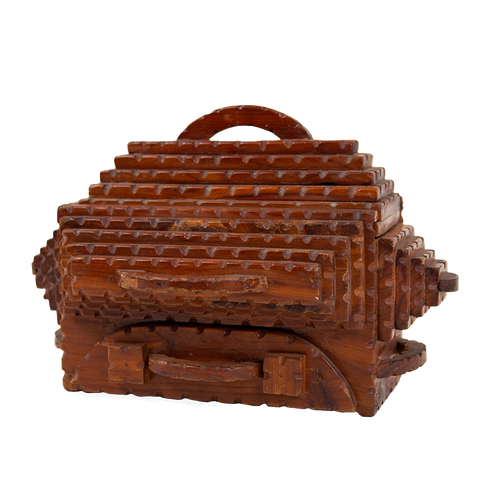Augustus “Gus” Wynn and His Prison Carnival

I take great delight in stumbling across obscure stories of lives that have been lived long ago, but that have possibly been all but forgotten. One such story is that of Augustus A. “Gus” Wynn, a man who transformed his bleak circumstances into something that captivated both inmates and the public alike. Born in 1890 and hailing from rural Harris County, Tennessee, Gus Wynn's life took an unexpected turn in 1936 when he was convicted of murdering his brother-in-law, Porter Johnson. While many prisoners languished behind bars, Wynn’s artistic ingenuity bloomed in the most unlikely of places—the Tennessee State Penitentiary.
A Murderous Dispute in Harris County
Gus Wynn was not a notorious criminal by trade, but a poor farmer trying to make ends meet for his wife and nine children in the harsh economic reality of rural Tennessee. By all accounts, Wynn and his brother-in-law, Porter Johnson, harboured deep animosity toward one another. Newspaper reports from the time detail the bad blood between the two men, a feud that would come to a head in front of a small town church.
On the fateful day in 1936, Wynn confronted Johnson. Although he claimed self-defence, the details were damning—Wynn emptied his revolver into the unarmed man, killing Johnson on the steps of the church. A jury found him guilty of first-degree murder, and while he could have faced the death penalty, the court instead sentenced him to thirty years in the Tennessee State Penitentiary.
Prison Life and the Birth of the Carnival
Wynn entered the penitentiary on September 3, 1936, at the age of 46. By all accounts, he was a small, shy man with thinning grey hair, described in contemporary reports as “unlearned” and quiet. He was not a man given to public speaking or grand gestures, and it seemed likely that he would fade into the shadows of prison life. But Wynn had other plans...

While incarcerated, Wynn taught himself to play multiple instruments simultaneously—a feat that included the banjo, harmonica, and a makeshift drum. But music was not his only talent. Using scrap materials and pieces of wood, Wynn built a miniature mechanical carnival, a marvel of creativity that he operated with his feet while playing music. This carnival was a sight to behold, with miniature Ferris wheels, animals, boxers, and even a tiny electric chair with a figure strapped into it, all brought to life by the simple pressing of pedals and levers.
Entertaining Behind Bars
On Sunday afternoons, Wynn's carnival became the highlight of the prison, attracting not only inmates but also prison staff and visitors. Seated in the midst of his intricate creation, Wynn entertained audiences with mournful tunes as his carnival figures danced and performed their routines. The spectacle was as captivating as it was unexpected, and it earned Wynn a reputation within the prison walls as a man of remarkable skill and determination.
But Wynn wasn’t just performing for entertainment’s sake—he was also seeking to support his family and secure his future. During his shows, Wynn would set out several carved wooden boxes, known as tramp art boxes, for donations. These boxes, with their sliding tops, allowed spectators to drop coins in exchange for the experience of Wynn’s carnival. If the coins were sparse, Wynn had another trick up his sleeve. He would stop the music and share the story of his life, including his conviction and the struggles of his wife and children. His heartfelt tales often loosened purse strings, and the donations would flow.
Wynn's 'Tramp Box'
Tramp Art and Creativity in Prison
The style of Wynn’s carvings falls under what is known as “tramp art,” a form of folk art associated with people using scrap wood to create intricate objects. Although often linked to itinerant or impoverished individuals, tramp art was practised by people from all walks of life during the late 19th and early 20th centuries. Wynn’s tramp art boxes, used to collect the coins from his carnival shows, were no exception to this tradition. They were finely crafted from discarded materials, showcasing Wynn’s skill and artistry despite the limited resources at his disposal.
Wynn’s creations were not limited to his carnival figures and donation boxes. Photographs from the 1940s show a stage crowded with his carvings, a testament to the breadth of his imagination. These creations weren’t just an escape for Wynn—they were a way of keeping hope alive during his long years of incarceration.
Guarding His Earnings
The coins Wynn collected from his shows were more than a means of earning a small income; they were his lifeline. In a twist befitting his resourceful nature, Wynn hid his earnings in a secret location within the prison, reportedly guarded by a swarm of bees—a creative if somewhat unconventional security measure. Over the years, Wynn amassed a small fortune by prison standards, and by the time his sentence was commuted, he had saved over six hundred dollars.
Freedom and a New Beginning
In 1950, after serving 14 years of his sentence, Wynn was granted a commutation by Tennessee Governor Gordon Browning. When he was finally released from the penitentiary, Wynn took his carefully guarded savings and deposited them at a Nashville bank. For a man who had spent over a decade behind bars, this modest fortune provided him with a new beginning.
Upon his return to Henry County, Wynn resumed his life as a farmer, this time with a nest egg that allowed him to start anew. And this was as much as I could find out about Augustus 'Gus' Wynn.



